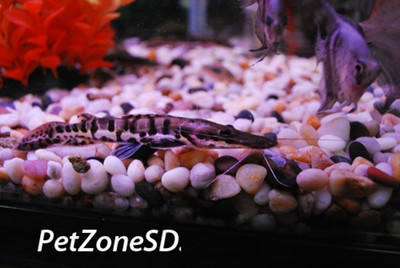Tiger Shovelnose Catfish
Posted by Max Gandara on on 8th Jun 2025
Tiger Shovelnose Catfish: A River Giant for the Fearless Fishkeeper
The Tiger Shovelnose Catfish is not your average aquarium fish. With its bold stripes, long whiskers, and powerful build, this South American river predator is a living embodiment of the wild. It demands respect — and lots of space.
Often admired for its stunning appearance and engaging behavior, the Tiger Shovelnose is best suited for experienced aquarists with the ability to house and care for a large, potentially aggressive fish. If you have the room and dedication, few freshwater fish can match its sheer presence.
Quick Overview
-
Scientific Name: Pseudoplatystoma fasciatum
-
Common Names: Tiger Shovelnose, Tiger Catfish
-
Family: Pimelodidae (Long-whiskered catfish)
-
Origin: Amazon and Orinoco River basins (South America)
-
Size: Up to 3.5 feet (106 cm) in the wild; 2–2.5 feet (60–76 cm) in aquariums
-
Lifespan: 18–25 years with proper care
-
Temperament: Semi-aggressive, predatory
-
Tank Level: Bottom to midwater
Appearance: Striped Predator Elegance
The Tiger Shovelnose is named for its bold black vertical stripes over a pale silvery body, resembling a tiger’s pattern. Its long, flat snout and distinctive whisker-like barbels give it a prehistoric look — perfect for a centerpiece in a massive aquarium.
-
Body: Long, muscular, torpedo-shaped
-
Barbels: Sensitive, used for detecting prey
-
Fins: Strong and slightly transparent, with sharp movement
-
Growth Rate: Fast — can outgrow small tanks in months
Tank Requirements
Minimum Tank Size:
-
300 gallons or more is ideal for an adult
-
Juveniles can be started in 100–150 gallons but will quickly outgrow it
Water Parameters:
-
Temperature: 75–82°F (24–28°C)
-
pH: 6.0–7.5
-
Hardness: Soft to moderately hard
-
Filtration: Very strong — produces heavy waste; high-capacity canister or sump systems are recommended
-
Substrate: Sand or smooth gravel
-
Decor: Large driftwood, rocks, and hiding spots — but leave open space for swimming
? Tip: Use a tight-fitting lid — these fish are powerful and known to jump.
Behavior and Compatibility
The Tiger Shovelnose is nocturnal, territorial, and predatory by nature. While it may seem calm as a juvenile, its behavior shifts as it grows.
Key Behavioral Traits:
-
Becomes more territorial with age
-
Will eat any fish small enough to fit in its mouth
-
Active, curious, and often patrols the tank at night
Compatible Tankmates (Only in massive tanks!):
-
Other large, robust fish like:
-
Pacu
-
Silver arowana
-
Large Oscars
-
Peacock bass
-
Other large catfish (e.g., redtail catfish — with caution)
-
-
Avoid: Small fish, invertebrates, slow or delicate species
⚠️ Warning: Never house them with fish under 6–8 inches. They will be seen as food.
Feeding and Diet
As a true predator, the Tiger Shovelnose has a high-protein diet and a powerful feeding response.
Best Foods:
-
Frozen or live foods: Shrimp, fish fillets, earthworms, silversides
-
Pellets: High-quality sinking carnivore pellets
-
Occasional treats: Raw mussels, squid, or feeder fish (quarantined and gut-loaded)
Feed once a day for adults; twice for juveniles. Do not overfeed — obesity and water quality issues are common.
Health and Maintenance
These catfish are hardy but require pristine water due to their size and waste production.
Common Issues:
-
Ammonia/nitrite spikes from heavy bioload
-
Lateral line disease from poor nutrition or water quality
-
Skin damage from hard décor or poor tankmates
Maintenance Tips:
-
Weekly 30–50% water changes
-
Strong, well-maintained filtration
-
Vacuum substrate regularly
-
Monitor nitrates closely
Breeding: Rare in Home Aquariums
Breeding Tiger Shovelnose Catfish in captivity is extremely rare and virtually unheard of outside large-scale aquaculture operations. They require massive space, hormonal triggering, and river-like conditions to breed naturally.
Is the Tiger Shovelnose Right for You?
Yes — if you have:
-
A 300+ gallon aquarium or indoor pond
-
Experience keeping large, predatory fish
-
High-capacity filtration systems
-
No small or delicate tankmates
-
A long-term plan (they can live over 20 years!)
No — if you:
-
Have a standard-sized tank (under 180 gallons)
-
Want a peaceful, community setup
-
Aren’t ready for a lifelong, large-predator commitment
Final Thoughts
The Tiger Shovelnose Catfish is one of the most visually stunning and behaviorally fascinating freshwater fish in the hobby. But it’s also one of the most demanding. With its massive size, predatory instincts, and need for space, this is a fish for dedicated, experienced aquarists only.
If you’re ready to care for a river giant and provide a home that mirrors its wild Amazonian roots, you’ll be rewarded with a captivating and majestic underwater predator unlike any other.

